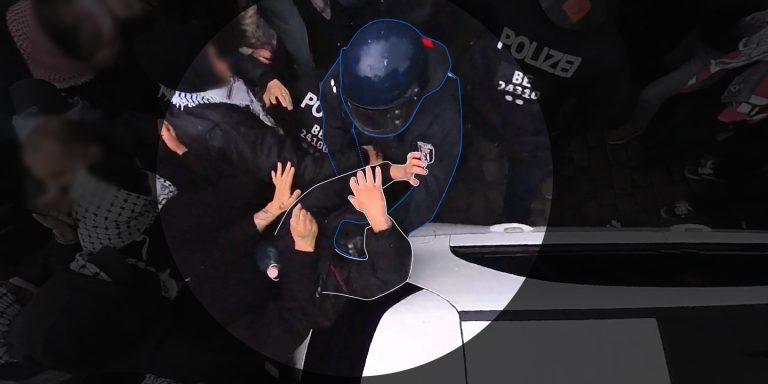Commissioned By
Additional Funding
Collaborators
- Palestinians and Allies
- Arrest Documentation Unit
On 15 May, protesters gathered in locations across Berlin for annual demonstrations to mark the anniversary of the Nakba.
At late notice, one of those demonstrations was denied permission to march, and was instead only permitted to assemble near Südstern, in southeast Berlin.
The protest at Südstern was subject to heavy police presence – according to figures released by the Berlin Senate, more than 800 officers were in attendance, for a crowd officially estimated to be around 1,000 people, gathering in support of the rights of Palestinians and in opposition to Israel’s ongoing genocidal military campaign in Gaza.
Following the end of the protest, the Berlin Police claimed that an officer, identified as BE-24111, had been ‘seriously injured’ at the hands of the demonstrators. According to a police spokesperson and a subsequent press release, the officer had been:
– Dragged into the crowd of protesters
– Intentionally attacked
– Pushed to the ground, and
– Trampled on by protesters
The content and spirit of these claims made by the Berlin Police were subsequently taken up by news reports, and repeated by local political figures. The Mayor of nearby Neukölln said the incident ‘could only be intepreted as an attempted murder’, while the Mayor of Berlin decried an ‘attack on our constitutional state’.
Police union representatives appeared on TV news channels to underline the same impression; one interviewee described crowds of demonstrators as ‘a gang of murderers’ who ‘would have killed the officer if they could have’.
Following those interviews and other reporting, federal interior minister Alexander Dobrindt repeated similar claims the next day in the German federal parliament, clearly connecting this incident to a need for new police powers:
‘An officer at an ‘Anti-Israel-Demo’ in Berlin was dragged into a crowd by aggressive demonstrators, and seriously injured there… The police, our security authorities, need the best possible equipment and appropriate powers … We will also make this clear in the law’.
The claims by the Berlin Police have informed political discourse and led to calls for further restrictions of fundamental freedoms and constitutional rights. But these cynical threats to civil liberties are founded on demonstrably false claims.
New video footage
Our investigation relied upon previously unseen video footage recorded by a member of the Palestine solidarity movement, using a 360-degree camera.
The video evidence provided by this camera seems to confirm one of the Berlin Police’s claims: that officer 24111 did indeed suffer an injury to his right hand during the incident in question. He is seen holding his right hand to his chest as if protecting it, shortly before leaving the assembly area. At the same time he appears visibly exhausted, doubling over near a barricade at the edge of the protest area.
However: the video evidence suggests that the injury suffered by officer 24111 was most likely caused by the officer repeatedly punching protesters in the head.

Before that time, the video evidence shows that 24111 voluntarily and purposefully entered the crowd with other officers to apprehend a protester. 24111 was not knocked to the ground, but went to ground intentionally, to pin down that protester. Other demonstrators nearby can be seen standing back from the scene, giving the officers space. The arrival of additional police officers leads to a chaotic scene. Shortly after, officer 24111 can be seen repeatedly punching demonstrators in the head and face as well as kicking a protester to the ground. It is only after making at least six punches with his right hand, that officer 24111 appears to show any signs of injury.
The demonstrations on Nakba Day 2025 took place against the backdrop of more than 18 months of escalating police violence against expressions of solidarity with Palestine in response to Israel’s ongoing genocidal military campaign in Gaza. A recent letter from the Human Rights Commissioner of the Council of Europe to the German govenment ‘raises concerns about restrictions to freedom of expression and freedom of peaceful assembly of persons protesting in the context of the conflict in Gaza’.